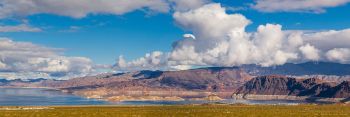Reservoirs: Difference between revisions
From ASDSO Dam Safety Toolbox
No edit summary |
|||
| Line 22: | Line 22: | ||
* [[Flood Pool/Storage]] | * [[Flood Pool/Storage]] | ||
* [[Emergency/Induced Surcharge Pool]] | * [[Emergency/Induced Surcharge Pool]] | ||
* [[Dead Pool/Storage]] | * [[Inactive/Dead Pool/Storage]] | ||
* [[Reservoir Rim]] | * [[Reservoir Rim]] | ||
* [[Sedimentation]] | * [[Sedimentation]] | ||
Revision as of 21:23, 3 January 2024

|
| Lake Mead, a reservoir formed by the Hoover Dam on the Colorado River, is the largest reservoir in the United States by water capacity.
(Image Source: National Park Service) |
Reservoirs are artificial bodies of water impounded behind a dam for one or more intended purposes including water storage, flood protection, hydropower generation, or recreation.
Components of a Reservoir
- Normal Pool/Storage
- Flood Pool/Storage
- Emergency/Induced Surcharge Pool
- Inactive/Dead Pool/Storage
- Reservoir Rim
- Sedimentation
Life Cycle of a Reservoir
Citations:
Revision ID: 7779
Revision Date: 01/03/2024
